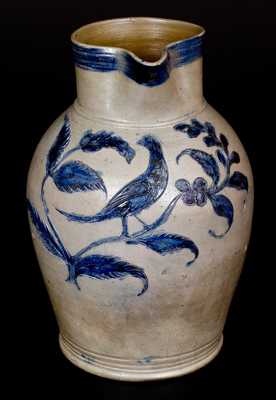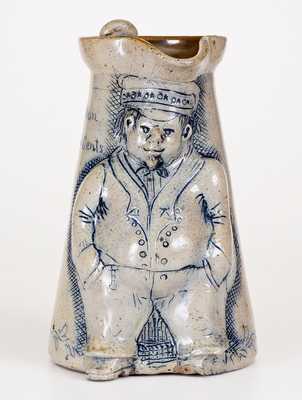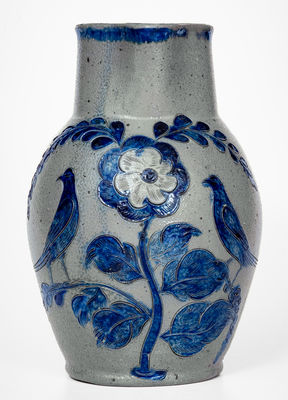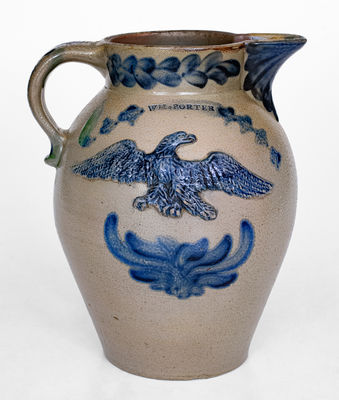Exceedingly Rare and Important Two-Gallon Stoneware Pitcher with Elaborate Cobalt Floral Decoration, attributed to George Duncan, Sycolin Road Pottery, Loudoun County, VA, second quarter 19th century, vasiform pitcher with tooled shoulder and semi-rounded rim, brush-decorated on one side with a tall flowering plant emanating from the base. Spout is formed with a series of finger impressions on each side, an unusual treatment. Artistic in form and decoration, this work features an appealing shape, lacking a stop between the collar and the body, complemented by bold and expressive brushwork. The placement of the decoration on one side of the pitcher, allowing the vessel to be displayed in profile, is innovative. This work is firmly attributed to potter, George Duncan (1788-1850), at the Sycolin Road Pottery in Loudoun County, Virginia based on its highly distinctive floral design, which is also found on a ring bottle bearing the signature and date, "George Duncan / 1827." According to Bertsch's JESDA article, Lost Potters of Loudoun County, Virginia: The Gardner-Duncan Family, Duncan worked with his brother-in-law, Charles Lewis Gardner (ca. 1778-1850), at a pottery in Loudoun County, Virginia, located on Egypt Farm along Sycolin Road. Other than the ring flask, only one other signed example of stoneware from this site has been recorded, a two-gallon floral-decorated jar, stamped "L. GARDNER / LOU.N. VA." Another jar with a local provenance, decorated with a house and bird, is also attributed to Gardner. This lot is the first pitcher attributed to this pottery to be documented. Its elegant form and proficient use of cobalt indicate a desire to produce ware that was highly decorative as well as useful. As only a few intact examples of pottery from the Sycolin Road site are known, this work is considered a significant discovery in our understanding of 19th century stoneware production in Northern Virginia. Literature: For more information on this pottery, see Bertsch "Lost Potters of Loudoun County, VA," Journal of Early Southern Decorative Arts, Volume 40, 2019. Handle broken into three pieces and reglued. Tight spider crack to base area connecting to a tight semi-circular crack on underside. A small, in-the-firing base chip. An in-the-firing contact mark to the undecorated side. Minor surface wear. H 13".















